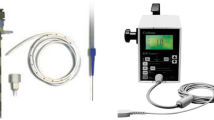Abstract
Purpose
The objective of our trial was to obtain more comprehensive data on the risks and benefits of kinetic therapy in intensive care patients with intracerebral pathology.
Methods
Standardized data of prone positioning in our NeuroIntensive Care Unit were collected from 2007 onward. A post hoc analysis of all available data was undertaken, with special consideration given to values of intracranial pressure (ICP), cerebral perfusion pressure (CPP) and oxygenation in correlation to prone (PP), or supine positioning (SP) of patients. Cases were considered eligible if kinetic therapy and ICP were documented. Prone positioning was performed in a 135° position for 8 h per treatment unit.
Results
A total of 115 patients treated with prone positioning from 2007 to 2013 were identified in our medical records. Of these, 29 patients received ICP monitoring. Overall, 119 treatment units of prone positioning with a mean duration of 2.5 days per patient were performed. The mean baseline ICP in SP was 9.5 ± 5.9 mmHg and was increased significantly during PP (p < 0.0001). There was no significant difference between CPP in SP (82 ± 14.5 mmHg) compared to PP (p > 0.05). ICP values >20 mmHg occurred more often during PP than SP (p < 0.0001) and were associated with significantly more episodes of decreased CPP <70 mmHg (p < 0.0022). The mean paO2/FiO2 ratio (P/F ratio) was increased significantly in prone positioning of patients (p < 0.0001).
Conclusions
The analyzed data allow a more precise understanding of changes in ICP and oxygenation during prone positioning in patients with acute brain injury and almost normal baseline ICP. Our study shows a moderate, yet significant elevation of ICP during prone positioning. However, the achieved increase of oxygenation by far exceeded the changes in ICP. It is evident that continuous monitoring of cerebral pressure is required in this patient group.



Similar content being viewed by others
Reference
Bein T. Positioning of patients with acute respiratory failure. Med Klin Intensivmed Notfmed. 2012;107:603–6.
Beuret P, Carton MJ, Nourdine K, Kaaki M, Tramoni G, Ducreux JC. Prone position as prevention of lung injury in comatose patients: a prospective, randomized, controlled study. Intensive Care Med. 2002;28:564–9.
Brower RG, Lanken PN, MacIntyre N, Matthay MA, Morris A, Ancukiewicz M, Schoenfeld D, Thompson BT. Higher versus lower positive end-expiratory pressures in patients with the acute respiratory distress syndrome. N Engl J Med. 2004;351:327–36.
Chesnut RM, Petroni G, Rondina C. Intracranial-pressure monitoring in traumatic brain injury. N Engl J Med. 2013;368:1751–2.
Gattinoni L, Tognoni G, Pesenti A, Taccone P, Mascheroni D, Labarta V, Malacrida R, Di GP, Fumagalli R, Pelosi P, Brazzi L, Latini R. Effect of prone positioning on the survival of patients with acute respiratory failure. N Engl J Med. 2001;345:568–73.
Gruber A, Reinprecht A, Illievich UM, Fitzgerald R, Dietrich W, Czech T, Richling B. Extracerebral organ dysfunction and neurologic outcome after aneurysmal subarachnoid hemorrhage. Crit Care Med. 1999;27:505–14.
Guerin C, Badet M, Rosselli S, Heyer L, Sab JM, Langevin B, Philit F, Fournier G, Robert D. Effects of prone position on alveolar recruitment and oxygenation in acute lung injury. Intensive Care Med. 1999;25:1222–30.
Guerin C, Reignier J, Richard JC, Beuret P, Gacouin A, Boulain T, Mercier E, Badet M, Mercat A, Baudin O, Clavel M, Chatellier D, Jaber S, Rosselli S, Mancebo J, Sirodot M, Hilbert G, Bengler C, Richecoeur J, Gainnier M, Bayle F, Bourdin G, Leray V, Girard R, Baboi L, Ayzac L. Prone positioning in severe acute respiratory distress syndrome. N Engl J Med. 2013;368:2159–68.
Mancebo J, Fernandez R, Blanch L, Rialp G, Gordo F, Ferrer M, Rodriguez F, Garro P, Ricart P, Vallverdu I, Gich I, Castano J, Saura P, Dominguez G, Bonet A, Albert RK. A multicenter trial of prolonged prone ventilation in severe acute respiratory distress syndrome. Am J Respir Crit Care Med. 2006;173:1233–9.
Naidech AM, Bassin SL, Garg RK, Ault ML, Bendok BR, Batjer HH, Watts CM, Bleck TP. Cardiac troponin I and acute lung injury after subarachnoid hemorrhage. Neurocrit Care. 2009;11:177–82.
Nekludov M, Bellander BM, Mure M. Oxygenation and cerebral perfusion pressure improved in the prone position. Acta Anaesthesiol Scand. 2006;50:932–6.
Reinprecht A, Greher M, Wolfsberger S, Dietrich W, Illievich UM, Gruber A. Prone position in subarachnoid hemorrhage patients with acute respiratory distress syndrome: effects on cerebral tissue oxygenation and intracranial pressure. Crit Care Med. 2003;31:1831–8.
Romero CM, Cornejo RA, Galvez LR, Llanos OP, Tobar EA, Berasain MA, Arellano DH, Larrondo JF, Castro JS. Extended prone position ventilation in severe acute respiratory distress syndrome: a pilot feasibility study. J Crit Care. 2009;24:81–8.
Taccone P, Pesenti A, Latini R, Polli F, Vagginelli F, Mietto C, Caspani L, Raimondi F, Bordone G, Iapichino G, Mancebo J, Guerin C, Ayzac L, Blanch L, Fumagalli R, Tognoni G, Gattinoni L. Prone positioning in patients with moderate and severe acute respiratory distress syndrome: a randomized controlled trial. JAMA. 2009;302:1977–84.
Thelandersson A, Cider A, Nellgard B. Prone position in mechanically ventilated patients with reduced intracranial compliance. Acta Anaesthesiol Scand. 2006;50:937–41.
Voggenreiter G, Aufmkolk M, Stiletto RJ, Baacke MG, Waydhas C, Ose C, Bock E, Gotzen L, Obertacke U, Nast-Kolb D. Prone positioning improves oxygenation in post-traumatic lung injury—a prospective randomized trial. J Trauma. 2005;59:333–41.
Zambon M, Vincent JL. Mortality rates for patients with acute lung injury/ARDS have decreased over time. Chest. 2008;133:1120–7.
Conflict of interest
On behalf of all authors, the corresponding author states that there is no conflict of interest.
Author information
Authors and Affiliations
Corresponding author
Rights and permissions
About this article
Cite this article
Roth, C., Ferbert, A., Deinsberger, W. et al. Does Prone Positioning Increase Intracranial Pressure? A Retrospective Analysis of Patients with Acute Brain Injury and Acute Respiratory Failure. Neurocrit Care 21, 186–191 (2014). https://doi.org/10.1007/s12028-014-0004-x
Published:
Issue Date:
DOI: https://doi.org/10.1007/s12028-014-0004-x




